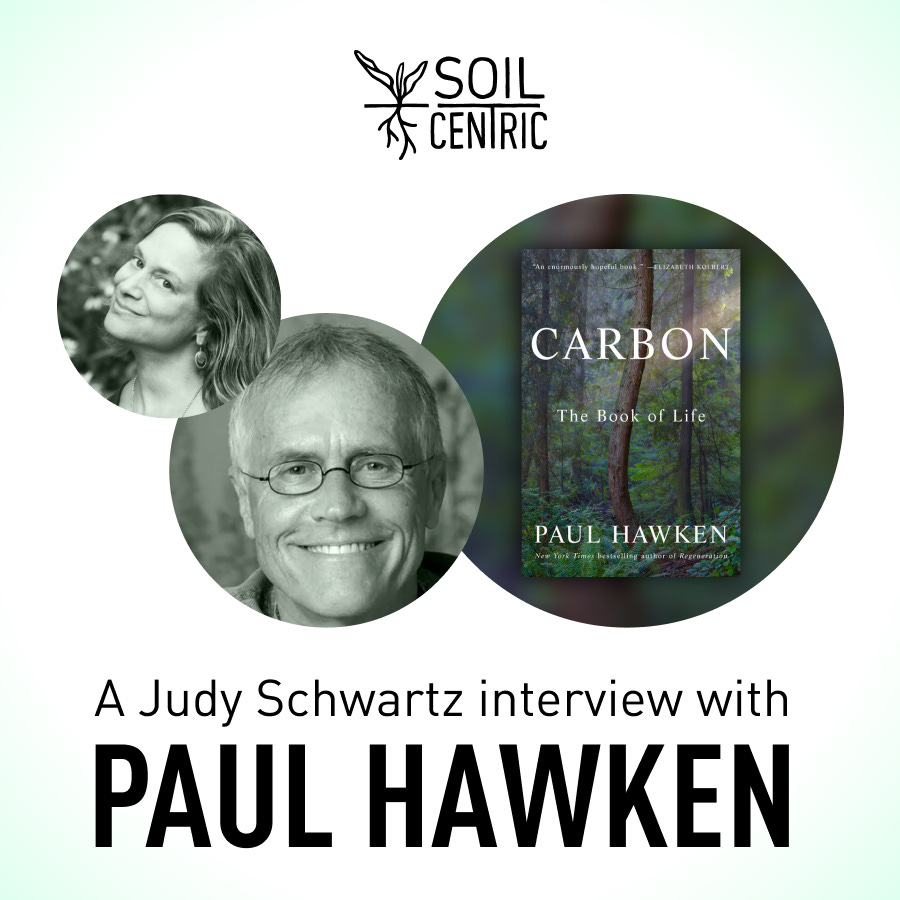Carbon is overdue for an image reset. Long maligned as the culprit in global heating, this mainstay of the periodic table has found its champion. In his new book, Carbon: The Book of Life, celebrated author Paul Hawken does more than restore carbon’s rightful place in the environmental pantheon: he captures the wonder of all that carbon animates. This includes us, for, as he points out, every human cell has some 1.2 trillion carbon atoms. Hawken moves deftly between science—such as the crystalline structure of carbon—and reveries on, for instance, plant communication and up-close encounters with moths. Through it all, he makes a compelling case that carbon’s earthly role is less about numbers of molecules and more about energy flows. This shift in perspective is pivotal to regenerative work in that it highlights opportunities to ally with nature’s patterns, rather than focus on what to fight against. There is no “fight” in this book. Rather, it’s full of awe and appreciation for how nature nourishes us. Here’s Soil Centric’s interview.
JDS: While we often hear of carbon as a “pollutant," your book offers a different view. What led you to write about carbon’s “dance of life” rather than carbon as a problem?
PH: Assigning the word “pollutant" to carbon is emblematic of a broader failure of climate communication. It is challenging to identify the origins of the narrative, but it arose from climate scientists who were justifiably alarmed about what they saw. This occurred earlier than there was much awareness by the public, academics, and governance. Scientists, in general, are not known for their communication skills due to peer review requirements. They accurately foretold global heating as a threat to civilization. Initially, the scope of the danger was ignored, sidelined, or downplayed (even to this day) by the media. Because of this, scientists and non-scientists, especially activists and NGOs, upped the ante on the myriad perils. It was an attempt at a wake-up call. The narrative was infused with fear, “existential threat,” foreboding. I would not argue with those conclusions. However, the narrative objectified carbon and climate as something that must be fought, tackled, and defeated. That framing, however, is the same one that created global warming. Western society has been objectifying the living world for 500 years: sailing around the globe, exterminating cultures, and selling all the resources—minerals, land, animals, forests—to the highest bidder. Today’s attempt to address the results of an extractive economic system is to sell carbon offsets to the highest bidder. This is the same mindset. Capitalism will never work unless we define it as the admixture of social, cultural, natural, and genetic capital. Seeing carbon as a pollutant is emblematic of how distant we have become from life's complexity and extraordinary beauty.
JDS: Regarding carbon as a “rogue element” leads to mechanisms like carbon trading, carbon credits, and a race toward “decarbonization”, none of which has benefited the environment. How might seeing carbon through the lens of life reframe what we see as “climate jobs”?
The climate narrative has created several terms that are scientifically impossible and incorrect. They include net zero, carbon neutral, decarbonization, carbon footprint, or carbon negative. Again, what we see is isolation and objectification. Carbon is a “thing" only in the table of elements. Functionally, it is the flow of life that infuses the entirety of the living world. In my opinion, regeneration should not be seen as a mere solution. When I created Project Drawdown, it was about ceasing to place anthropogenic CO2 into the atmosphere and finding ways to bring it back home. But even before I set pen to paper for Drawdown, I knew I would write Regeneration because the only path forward for humanity is to increase life on Earth. Period. Regeneration is not merely a solution. It is being in alignment with our home, the living world.
JDS: You compare English, which favors “nouns,” with Indigenous languages that accentuate verbs, noting that English’s emphasis on distinct entities rather than processes leads to distancing from nature. How might one shift to a verb-centered understanding?
PH: The Scientific Revolution, born from the Age of Enlightenment, significantly influenced the language of the West. Science is about distinctions, analysis, and naming. This is not a that. Science isolates and separates to enhance our understanding of the world around us. It was and remains a brilliant achievement of humankind. It also had the unfortunate effect of distancing human beings from the living world, even as it has mapped and analyzed the extraordinary catalog of life. Indigenous languages arose from people whose lives depended on an intimate knowledge of place. To survive in a place without outside inputs, one has to understand the intricate interactions within complex adaptive ecosystems. This is called traditional ecological knowledge (TEK)—observational science compared to empirical science. TEK is about relationships, thus verbs, not names. This isn’t about one way of seeing the world being better. What we are seeing today is the merging of these two different scientific disciplines.
JDS: The book gives readers a sense that carbon has agency, even wisdom. How might humanity’s relationship with the broader living world change if we asked questions like “what does carbon want?” or “what would carbon do?”
PH: This objectifies carbon as well. We might ask: What do we want? Do we want to live in a world where 60-70 percent of pollinators have disappeared? Did we want a 73 percent reduction in animal life on the planet in the past fifty years? Do we want to see the mantle of Earth, the soil, the source of all land life, obliterated by chemicals? Do we want to pursue bogus technological solutions such as direct air capture (DAC), carbon capture systems (CCS), bio-energy carbon capture systems (BECSS), etc? We might ask ourselves this: there are approximately 8.4 million species and about 3.4 trillion creatures overall on Earth. Do we want to be the only species that dysregulates the atmosphere by destroying the biosphere?
JDS: You reckon with these difficult scenarios, but also note wonderful examples of regeneration, like the rewilding of Knepp Estate. What are you most excited about now?
PH: What I see as promising is largely overlooked. Life only exists in a community, starting with the living cell, which itself is a community. I see communities worldwide arising to restore their habitat, food, farming, cultures, and ecosystems. Many of us know one or two or even several. But few, if any, of us know how many thousands of groups are coming together and responding to the myriad challenges we face. They are regenerating life on Earth in the best way they can. This does not make the news. We see, hear, and read about top-down “solutions” from governments, corporations, and international organizations, such as the three annual Conference of the Parties (COP) discussing climate, biodiversity, and land use. How did the Paris Mandate work out? Top-down solutions will never work because nature is not top-down. Unfortunately, corporations are top-down, as are oligarchies, fascism, and war. We are at the cusp of systemic failure of what top-down entities have created. I have lived in California, one of the most fire-prone areas in the world, my whole life. When I was young, I lived in the Sierras, and when there was a fire, usually in the summer or fall, it was fought by professionals and local volunteers. What was left was ashes, a bleak, black landscape. But in the spring, it was extraordinary. The grass was emerald green, nourished by the minerals from the ash. There is a phenomenon known as fire-triggered germination. Some wildflowers evolved to respond to heat and charcoal-infused soil, remaining dormant for decades. The fire causes a reset, known as ecological succession. I believe my regenerative farmer friends and the extraordinary related initiatives occurring in the world today are the human equivalent of ecological succession.







JDS with another welcome serving of science and hope
Brilliant, and worded beautifully. I can’t wait to read it.